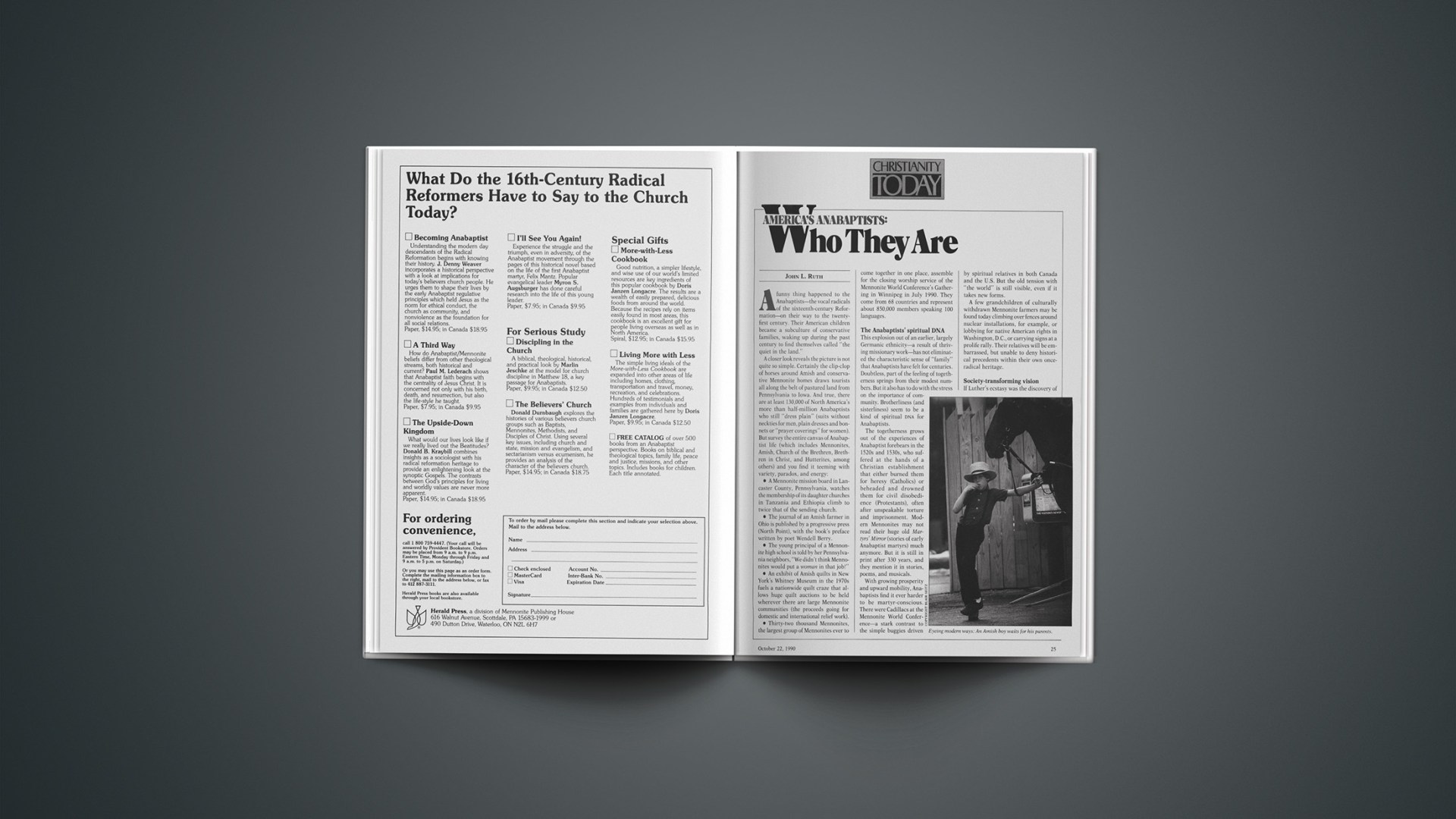A funny thing happened to the Anabaptists—the vocal radicals of the sixteenth-century Reformation—on their way to the twenty-first century. Their American children became a subculture of conservative families, waking up during the past century to find themselves called “the quiet in the land.”
A closer look reveals the picture is not quite so simple. Certainly the clip-clop of horses around Amish and conservative Mennonite homes draws tourists all along the belt of pastured land from Pennsylvania to Iowa. And true, there are at least 130,000 of North America’s more than half-million Anabaptists who still “dress plain” (suits without neckties for men, plain dresses and bonnets or “prayer coverings” for women). But survey the entire canvas of Anabaptist life (which includes Mennonites, Amish, Church of the Brethren, Brethren in Christ, and Hutterites, among others) and you find it teeming with variety, paradox, and energy:
• A Mennonite mission board in Lancaster County, Pennsylvania, watches the membership of its daughter churches in Tanzania and Ethiopia climb to twice that of the sending church.
• The journal of an Amish farmer in Ohio is published by a progressive press (North Point), with the book’s preface written by poet Wendell Berry.
• The young principal of a Mennonite high school is told by her Pennsylvania neighbors, “We didn’t think Mennonites would put a woman in that job!”
• An exhibit of Amish quilts in New York’s Whitney Museum in the 1970s fuels a nationwide quilt craze that allows huge quilt auctions to be held wherever there are large Mennonite communities (the proceeds going for domestic and international relief work).
• Thirty-two thousand Mennonites, the largest group of Mennonites ever to come together in one place, assemble for the closing worship service of the Mennonite World Conference’s Gathering in Winnipeg in July 1990. They come from 68 countries and represent about 850,000 members speaking 100 languages.
The Anabaptists’ Spiritual DNA
This explosion out of an earlier, largely Germanic ethnicity—a result of thriving missionary work—has not eliminated the characteristic sense of “family” that Anabaptists have felt for centuries. Doubtless, part of the feeling of togetherness springs from their modest numbers. But it also has to do with the stress on the importance of community. Brotherliness (and sisterliness) seem to be a kind of spiritual DNA for Anabaptists.
The togetherness grows out of the experiences of Anabaptist forebears in the 1520s and 1530s, who suffered at the hands of a Christian establishment that either burned them for heresy (Catholics) or beheaded and drowned them for civil disobedience (Protestants), often after unspeakable torture and imprisonment. Modern Mennonites may not read their huge old Martyrs’ Mirror (stories of early Anabaptist martyrs) much anymore. But it is still in print after 330 years, and they mention it in stories, poems, and musicals.
With growing prosperity and upward mobility, Anabaptists find it ever harder to be martyr-conscious. There were Cadillacs at the Mennonite World Conference—a stark contrast to the simple buggies driven by spiritual relatives in both Canada and the U.S. But the old tension with “the world” is still visible, even if it takes new forms.
A few grandchildren of culturally withdrawn Mennonite farmers may be found today climbing over fences around nuclear installations, for example, or lobbying for native American rights in Washington, D.C., or carrying signs at a prolife rally. Their relatives will be embarrassed, but unable to deny historical precedents within their own once-radical heritage.
Society-Transforming Vision
If Luther’s ecstasy was the discovery of grace, the Anabaptists, emerging in the Swiss-German regions that saw the violent Peasants’ Revolts, rejoiced in a rediscovery of the Sermon on the Mount. To them it was definitive good news. Here and in Matthew 18 (with its emphasis on reconciliation) was society-transforming hope—a paradigm of kingdom ethics. They believed that humans could live that way, both individually and socially.
Why else was the Sermon on the Mount recorded? To tantalize us with the image of a society for which we must wait until another age? “No!” wrote an impassioned young Conrad Grebel of Zurich, an early Anabaptist leader, “the Gospel was given in order that it be carried out.”
The reason that Christians do not find the Sermon on the Mount making practical sense in daily life, Anabaptists argue, is that they do not factor the Cross into the equation. Following the pattern of behavior Christ taught and lived may indeed be costly.
This emphasis on the cost of discipleship goes back to the Anabaptists’ earliest beginnings. Zurich’s reformer Ulrich Zwingli, tormented by conservative critics of his reforms, grew exasperated with the young Bible students he once mentored who were now advocating more radical reform. They were giving his program the stigma of fanaticism by refusing to have their babies baptized, citing his own earlier ideas.
When they finally began baptizing each other in January 1525, Zwingli agreed that they deserved capital punishment, not for doctrinal heterodoxy, but for tearing the fabric of a seamless Christian society. “The earth is the Lord’s,” responded Anabaptists from Zurich and Bern, “and our Lord has told us plainly not to swear or fight. This kingdom must take precedence in deciding human behavior.”
Despite the eventual execution of some 4,000 of the Anabaptists’ most vocal early leaders, as well as confiscation of their farms, the Anabaptists articulated their message so vigorously that their fellowship continued to spread into centers of influence in Germany, Switzerland, Moravia, and elsewhere.
A Faith That Will Not Lie Sleeping
One of the steadiest leaders on the volatile Anabaptist scene was Menno Simons, a priest from Friesland, a small country north of the Zuiderzee in Holland. After other Anabaptists led a violent takeover of the Westphalian town of Munster, Simons emerged as a moderate in the early sixteenth century. His motto was “no other foundation” than Christ. Christians, he taught, must give up all violence, as had Christ. And they must “come out from among the world” and be pure, as Christ was pure. Just how pure, it turned out, was a question that would eventually lead to lengthy wrangles on church discipline.
Menno Simons died faithful to his vision but disappointed with divisions in his flock. He would have been aghast to know that both his name and the tendency for his flock to divide—sometimes over such issues as buttons or the appropriateness of radios—would survive him by four centuries.
Simons’s American children are indeed arranged today in a colorful array of separated communions. From the Swiss Anabaptists who accepted his teachings, there emerged in 1694 an especially strict group named “Amish” after their aggressive young leader, Jacob Amman (see “The Amish: Plain—but Not Ordinary—People,” p. 28; “Growing Up Anabaptist,” p. 27).
The influence of Anabaptists like Menno Simons also helped give rise to another group, the New Baptists, also called Dunkers—or more commonly, Brethren (not to be confused with the historically distinct Plymouth Brethren). Alexander Mack was the first leader; on an August morning in 1708 in Schwarzenau, Germany, he and his followers baptized one another in accordance with their understanding of the command of Christ. His descendants, the largest being the Church of the Brethren (others include the Grace Brethren, the Brethren Church, and the Old German Baptist Brethren), trace roots to Anabaptism, as well as Pietism. They share a concern for community, radical discipleship, literal adherence to the Sermon on the Mount, nonresistance, and nonconformity.
In America, Mennonites have divided so often over church polity and degrees of “nonconformity” that the largest of their “conferences” (a grouping of congregations that functions like a denomination) contains only a third of the entire family. Many of the conferences have not been willing officially to do mission work together (though individual missionaries often do).
Yet when a natural disaster strikes, all stripes of present-day Anabaptists, from bearded Amish to pony-tailed Brethren suburbanites, may show up to ply their crowbars and scrub brushes. Floods, hurricanes, and tornadoes have provided Mennonite and Brethren disaster volunteers a host of opportunities in recent years to lend their muscle to concrete expressions of compassion.
And even with a miscellany of conferences, one major agency—the Mennonite Central Committee (MCC)—serves the great majority of North American Mennonites in relief and development. (MCC participants include the Mennonite Church, General Conference Mennonite Church, Mennonite Brethren Church, Brethren in Christ, Beachy Amish, Church of God in Christ, and the Evangelical Mennonite Church.)
The Church of the Brethren is also active in disaster and relief efforts, often in cooperation with mainline ecumenical organizations. Indeed, the origins of CROP, the community hunger appeal agency of the National Council of Churches’ Church World Service, owe much to postwar Brethren leadership in the 1940s.
Growing Up Anabaptist
In the movie Witness there is a wonderful moment in the film when the young Amish boy, Samuel Lapp, sees a man—a Hasidic Jew—with a beard and broad-brimmed hat in a Philadelphia train station. Approaching the older man, Samuel expects to be able to relate to the grandfather figure, even though he does not personally know him. But as the two exchange inquiring glances, each recognizes that the other is not “one of us,” whatever the similarities in dress. The uninitiated might assume that the two belong to the same group or sect, but to the “insider” the differences (even as viewed by a youngster) are instantly apparent.
Looking at the surprised young Samuel, I think of my own childhood, growing up Amish. It is my first day of school at a small-town consolidated grade school in rural Kansas. At the school yard I leave behind my mother, who is trying—with only limited success—to swallow her tears. The youngest of eight children, I was the first to attend a “city” school, the others all having graduated from one-room schools. With my distinctively simple clothes, I am the only “plain” boy in the school, though I am not too aware of—or worried about—such cultural differences. Besides, I am athletic enough on the playground and intelligent enough in the classroom to fend for myself on this unfamiliar turf.
I soon become aware, however, that I have entered a new world, a world that often does not share my community’s values. I never tell my parents, for example, that I play cops and robbers or cowboys and Indians with the other first- and second-graders. Shooting others or “playing dead” would—I know without asking—be met with disapproval. Nor do I tell them that Sue C., with her long, blond hair, her freckled nose, and her impish grin, is the cutest girl I have ever known. She will remain forever an “outsider,” and even at six I know I would never marry her kind.
Years pass, and a 12-year-old lad with a strong arm and a decent eye for home plate stands on the pitcher’s mound. It is my first real game. I face the twin challenge of getting the ball across the plate with enough finesse to keep the opposing team off balance and—more difficult—of ignoring the derisive hoots of the other school’s team and spectators. No one on either team wears a uniform, but I become painfully aware that my straw hat and distinctive clothes mark me as being different. “A good pitcher doesn’t have rabbit ears,” I had read in a baseball novel; I determine to ignore the jeers. I will prove that I can pitch as well as anyone.
A year later I am playing basketball with my school team. Having had an early growth spurt, I am a starting forward. After a moderately good season, the team is now in the league tournament’s semifinal game. I want my team to win, of course, but I know that the championship game will be played on Saturday night. This Saturday is a problem because I am to be baptized and become a member of the church on Sunday. Because baptism is such an important event, I know that I will not be permitted to play.
Conflicting feelings race through my mind. How can I say no to my coach and team? How can I convince my parents to say yes? As I run up and down the court, I pray, “Dear God, help me to do my best, but please let our team lose.” At the end of the game, exhausted, I sigh with relief. We have lost.
Lines sharply drawn
My childhood was not unhappy, nor were days at school filled with Dickensian misery. But it was clear as I grew up that I was part of a distinctive fellowship—and not part of the “world.”
Was not the Bible absolutely clear in its commandments? “Love not the world, neither the things that are in the world.” “Be not conformed to this world, but be ye transformed by the renewing of your mind.” “ ‘Wherefore come out from among them, and be ye separate.’ saith the Lord.”
Us and them: the lines were sharply drawn. Here there was no question of an “invisible” church. We were highly visible, and not only were our lives open to examination by the church fellowship, but “outsiders” subjected us to constant scrutiny.
While I have since left the Amish church, one thing I recall with certainty from my childhood: I knew that I and my family belonged to a people, a people who cared for us and supported us. We knew who we were. We were willing to accept disjunction with the larger surrounding culture in order to be one with our community of faith. While the context has changed, I still have something to learn from such a courageous approach to faith and life.
By Isaac Miller.
Beyond The Warmth Of Cow Stables
Despite the emphasis on service to others, Anabaptist groups generally took longer than Baptists or Methodists to take up mission work in the modern style. After their first fervor for witness had been bloodily subdued, they settled into what a German scholar has called “the warmth of the cow stable.” Tradition and family were the methods of propagating the faith and fellowship.
That these can be effective is evident in today’s phenomenal growth of the nonmissionary “Old Order Amish” fellowship in the U.S. (And try to explain to an Amishman, with thousands of tourists craning their necks at his way of life, that his church has “no witness.”) But as they have given up the German language over the past century, American Mennonites have been awakened to active mission by other evangelicals. Today they hear constant urgings from other groups to share the good news of their heritage.
One part of the Anabaptist family was indeed quicker to adopt active outreach—the Brethren. Awakened by pietist influence, they looked admiringly at Anabaptist teaching, and might have joined the nonresistant Mennonites if the latter baptized by immersion (rather than pouring or sprinkling) and had not lost so much of their original fervor for witness. Even so, this small group migrated to America side-by-side with Mennonites and tended to settle in the same regions (such as Pennsylvania and Virginia). Here and on the expanding frontier their pietistic fervor gave them an early and decided advantage in soul winning, to the point that the strength of their numbers grew to match that of the Mennonites.
The Mennonites’ active overseas mission work, however, has given them a more international flavor. There are 5,000 Massai ex-warriors in East Africa, for example, who have recently said they would like to be Mennonites, because Mennonites understand cows. At the Winnipeg conference in July, a Zairian Mennonite reported that Mennonites have baptized 2,000 Pygmies. A session or two later, a Guatemalan children’s choir stole the show.
A table conversation at the conference comparing mission work by Southern Baptists to that of Lancaster, Pennsylvania, Mennonites revealed a startling point: the Lancaster mission board has sent some 160 missionaries from its home membership. Were the ratio that of the Southern Baptists, says a missions board officer, the Lancaster Mennonites would have only two.
The Amish: Plain—but not Ordinary—People.
Many persons are startled to discover that membership in the Amish church has doubled over the past two decades. This growth comes almost exclusively from the large Amish families, but is testimony to the strength of these tightly knit Christian communities where a large majority of the young people choose to remain Amish.
In a society seeking quick joy and relentless stimulation, the Amish teach humility, modesty, and learning one’s place within the community of faith. Where the world cries, “More, more!” the Amish give thanks for “enough.” In my work directing a Mennonite and Amish heritage and cultural center in the heart of Pennsylvania Amish country, I find that many Americans suppose that with a little more alertness and intelligence, the Amish would choose to be modern. This is not so; the Amish believe their way of life represents a viable alternative to the modern way.
The glue that holds them together
The Amish date their beginnings to the Anabaptist movement of the 1500s. They separated from the Mennonites in 1693 when a young Mennonite leader named Jacob Amman began calling the churches in Alsace (now part of eastern France) to greater faithfulness. His movement won wide support in the Alsace. Those choosing Amman’s movement were nicknamed “Amish.”
Today more than 120,000 “Old Order” Amish (referring to those who drive horse and carriage) thrive in communities in 21 states and in the Canadian province of Ontario. More than 70 percent live in Pennsylvania, Ohio, and Indiana. Actual church membership is about 56,000, but young people and children who have not yet been baptized normally live within the “order” of the communities.
Farming is the preferred vocation, and the Amish relate to the soil with singular earnestness. Increasingly, however, shortages of land and urbanization mean that Amish young men cannot find farms. They turn to farm-related business, cottage industries, and woodworking trades.
The Amish will go to great lengths, however, to avoid carrying a lunch pail; when the husband works away from home, they observe, everything seems to change: His work is rewarded with a paycheck (as though that work were more important than his wife’s), partnership between spouses is broken, and the wife is more heavily burdened with the care of both the children and the grandparents (who often retire in a small addition to the main house).
The community “glue,” however, comes from religious life and discipline. Church government is congregational; there is no central office or leader. Each church district generally has a bishop, two ministers, and a deacon. Potential leaders are nominated by members’ votes; the lot (as used in the Book of Acts) is then employed to select the new leader. Leaders normally serve for life and are not paid a salary; they maintain a separate livelihood. Women may vote but are not eligible for ordination.
The key to members’ contentment is willingness to live within the boundaries set for their lives by the community. Dress styles are prescribed; technology is carefully restricted; education is redefined. The central question for the Amish is “How can we live together as God’s humble, obedient people, in the world but not of it?”
Family life is another important ingredient of Amish life. All major events take place at home: birth (if possible), weddings and funerals, worship services, mutual-aid meetings (to organize help for community members with urgent needs), and endless family events and celebrations. The only Amish institution functioning outside the home is the Amish school, which goes only to eighth grade.
Points of tension
The Amish are not all the same, and great variety exists from community to community. Rulings on technology may vary, for example, on issues such as using bicycles, or having bulk milk tanks on dairy farms. But within a given district, one will find great uniformity.
Not all stay Amish, of course. Most who leave say they want more “spirituality,” meaning greater stress on assurance of salvation, more worship services, and more involvement in formal missions (which the Amish traditionally oppose). Such persons join the Mennonites or a related group.
The Amish also face a dilemma of self-interpretation. Millions of moderns are drawn by the Amish witness; many tourists look on wistfully as they visit Amish areas. But the Amish show little interest in explaining themselves. For many, articulation by life is more important than articulation by word.
By Merle Good.
In Search Of Good Land
Not only are Mennonites becoming more international, the proverbial Mennonite farm that Reinhold Niebuhr used to call “a Protestant surrogate for the monastery” is rapidly losing its owners. Half of General Conference Mennonites are already urban. Almost every major city in the U.S. and Canada has Mennonite churches in which people from every possible ethnic background have taken the name Mennonite.
In spite of these trends, many American Anabaptists—especially the Amish—remain ardent farmers. A feeling for good land is in their history; they have been said to follow it “as the needle follows the pole.” For instance, if you drive south from Bingen, Germany, on the Rhine, until you cross the long rise that is the northern horizon of the ancient Pfalz (“Palatinate”), the view sucks a collective “ahh” from a bus load of Mennonite tourists. This is the verdant breadbasket whose fields the Swiss “brothers” helped to restore after Europe’s Thirty Years’ War (1618–48). They had been invited because a decade as refugees in Alsace had won them a reputation for agriculture. In a few years, they had blooming Palatine farms—and jealous neighbors. It was here that the Swiss accepted the Dutch name Mennonite because it seemed less threatening than Anabaptist, a name they themselves had never acknowledged. And it was because this land was soon too full that many of them left it in the 1700s, making up perhaps 3 percent of a stream of 100,000 German-speaking immigrants to Pennsylvania.
Amazingly, if you drive up to Gdansk in Poland (earlier known as Danzig), one finds a similar story: wide fields originally drained and saved from being useless marshland by members of the other great wing of Anabaptists, the Dutch Mennonites. The children of the swamp drainers were invited onto land near the Black Sea, where for two centuries they would thrive as premier agriculturalists of Russia. Their descendants now farm land stretching from Oklahoma to British Columbia.
Surprisingly, for a group so historically wedded to the land, Mennonites have offered environmental causes relatively modest support. There are important exceptions, but Mennonite ideas are more implicit in a lifestyle than laid out in aesthetic or argumentative patterns. And, of course, the more they move away from a “plain,” culturally separate ethos, the more their farming resembles modern agribusiness. Conscientious young farmers wince at this and debate the merits of chemicals and irrigation. All the while the Amish, who make little distinction between work and recreation, stand ready to buy the farms eastern Mennonites and Brethren are increasingly willing to sell.
Slaying The Emnity, Not The Enemy
However little Anabaptists may have said about the environment, they have made up for it in their stance toward war. Anabaptists are imprinted with the conviction that “with Christians all killing has stopped.” That axiom was laid down even before the first baptisms took place in Zurich in 1525. And, after some confusion, it was reiterated two years later in the Schleitheim Confession in Seven Articles (the first confession adopted by the emerging Anabaptists). An Anabaptist is likely to think of Christ’s Cross, the Atonement, as slaying the enmity, not the enemy.
Today’s Anabaptists descend from the pacifist wing of the early movement; other wings self-destructed or dried up. Some Mennonites and Brethren (but no Amish or Hutterites) say they may now take up the sword if it is in the service of civil order, but this is often felt to be a betrayal of the heritage by others.
After the Soviet invasion of Afghanistan, as Sen. Jesse Helms suggested new legislation that would exclude the option of conscientious objection to military service, a Mennonite leader could tell his congressman that if such a law were passed, the government could expect thousands of Mennonite young men in federal prisons. Called “pacifists” by many, Mennonites of a traditional stripe have usually said, “We are simply being nonresistant, according to Christ’s teaching and example.”
Nonresistance, coupled with an emphasis on nonconformity, once meant staying out of the world’s power struggles. It still means that for the large groups that wear plain coats and prayer coverings. Nonresistance has recently been called by a thoughtful Mennonite scholar the most intrinsic thought in the Mennonite attitude. However, an unexamined or static notion of nonresistance has sometimes led to an attitude of simply expecting the government to do the fighting and protect the people. Such withdrawal feels too narrow to some in recent generations, leading some Mennonites and Brethren to become lawyers, lobbyists, even legislators. Also, modern Mennonites and Brethren tend to be heavily represented among social workers, teachers, and other helping professions.
With such questions about relating to wider culture at the fore, it is no accident that Anabaptists are in the thick of internal discussions about identity.
Rrecently, to cite one example, I baptized into my 270-year-old Mennonite congregation in eastern Pennsylvania (where everyone lived on farms two generations ago) people with backgrounds in nine denominations other than Mennonite. They ranged from a fork-lift operator to a hair stylist to a former Buddhist couple working in a factory. What mattered to them was not the name Mennonite, but the chance to join a community where faith was expressed in practical terms.
Some of the older, “ethnic” members of Anabaptist congregations hardly know what to make of the influx. (The term ethnic is not quite right, because some of our new members are as ethnic, with their Hispanic or Asian backgrounds, as we are with our Swiss-German heritage.) Until the midsixties, when we still had rules about plain dress (earlier for Brethren groups), hardly anybody but our own children—and not all of them—joined our congregations. With those barriers down, people are knocking on our doors.
Anabaptist churches mostly welcome the new faces, but recognize a danger, as well: Perhaps we will become so “average” in what we require by way of discipleship that we will end up with little that is distinctive or radical.
Most Anabaptists believe, however, that there is too much in the heritage for their congregations simply to become “community” churches. What their spiritual ancestors discerned in the caves and barns of Zurich and Bern and Friesland, where they met under the heat of persecution, has left an indelible impression on the “quiet of the land,” making them all the more eager to join with other Christians in becoming the salt of the earth.









